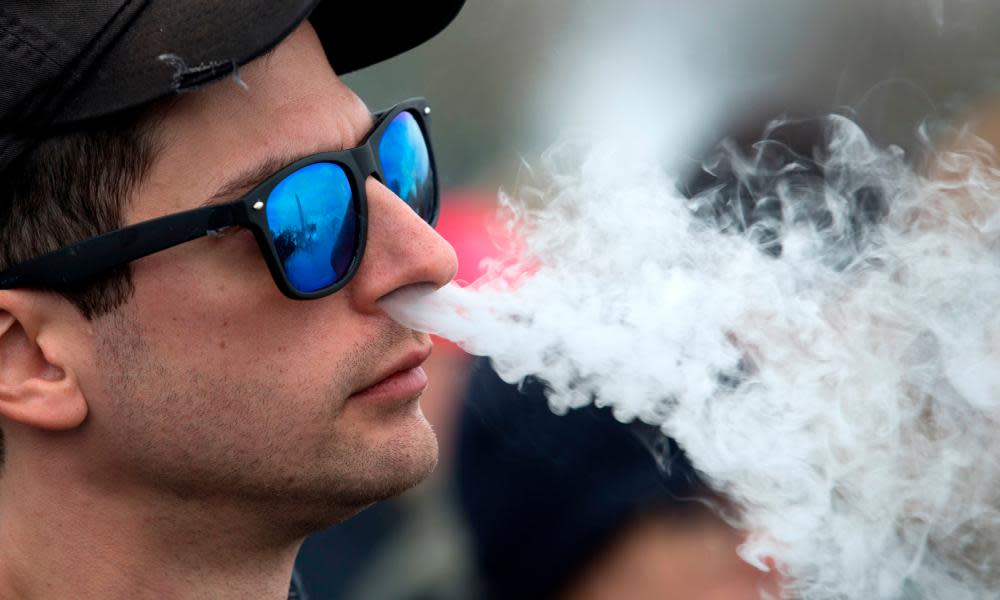E-cigarette use among young Australian non-smokers quadruples in six years, survey finds

Fewer Australians are smoking tobacco daily, while more are vaping and using e-cigarettes, results from the latest National Drug Strategy Household Survey found, with e-cigarette use among non-smokers aged 18 to 24 years quadrupling in six years.
Conducted annually for the Australian Institute of Health and Welfare, the leading survey of licit and illicit drug use in Australia asked 22,274 people aged 14 and over about their drug use patterns, attitudes and behaviours. The sample was based on households, so people who were homeless or institutionalised were not included in the survey.
The 2019 results published on Thursday found about 3.7% of teenagers, 10.7% of people in their 20s and 11.6% of people in their 30s smoked daily in 2019. These proportions have more than halved since 2001. Over the same period, the proportion of younger people who have never smoked continued to rise.
Between 2016 and 2019, use of e-cigarettes rose across most age groups, but the rise among young adults was particularly notable. Nearly two out of three current smokers and one in five non-smokers aged 18–24 reported having tried e-cigarettes.
Related: 'A lot of people have relapsed’: isolation has been a mixed blessing for drug addicts
The director of centre operations at Melbourne University’s Centre for Behaviour Change, Dr Michelle Jongenelis, said the increased e-cigarette use among Australians was “very concerning”.
“Although marketed as a healthier alternative to traditional cigarettes, e-cigarettes are not harmless and there are significant health risks associated with their use,” she said. “Short-term consequences of use have been known for quite some time and data on the long-term health consequences of e-cigarette use are beginning to emerge, with studies linking vaping with cell death and increased risk of cardiovascular disease and cancer.”
The increasing use of e-cigarettes among young adult non-smokers is especially worrying, Jongenelis said. Use among non-smokers aged 18 to 24 years rose from 5% in 2013 to 20% in 2019. Furthermore, 65% of adolescents and 39% of young adults report using e-cigarettes despite having never smoked.
“These concerning proportions are likely being driven by the vaping industry’s narrative that e-cigarettes are ‘harmless’,” Jongenelis said. “Increasing use among non-smoking youth also speaks to the vaping industry’s continued targeting of this population via youth-oriented marketing and the development of new youth-oriented e-juice flavours.”
Meanwhile, the proportion of young people who drink alcohol at risky levels fell between 2001 and 2019. This pattern was seen among all age groups under 40, but the proportion of risky drinkers was lowest among teenagers. “In 2001, 40% of 14 to 19-year-olds exceeded the single occasion risk guidelines, but this fell to 20% in 2019,” the report found. “Over the same period, the proportion who exceeded the lifetime risk guidelines fell from 19.8% to 6.0%.”
In older people, little changed in smoking and drinking patterns. People in their 40s and 50s are more likely than other age groups to smoke, with about one in six people in these age groups smoking daily in 2019. This proportion has not improved since 2016. In 2019, among men, people in their 40s were the most likely to smoke daily while for women, it was those in their 50s.
“Compared with people in major cities, people in remote and very remote parts of Australia were twice as likely to smoke daily; 1.5 times as likely to drink at levels that exceed the single occasion risk guidelines (at least monthly) and 1.6 times as likely to exceed the lifetime risk guidelines,” the report found.
Meanwhile one fifth of Australians, or 4.5m million people, had been a victim of an alcohol-related incident in 2019 whether being verbally or physically abused, or feeling fearful of someone under the influence of alcohol. This proportion has not changed since 2016.
“Over the past two decades, there has been a clear trend of increasing illicit drug use among people in their 40s and 50s,” the report found. “Recent cannabis use among those aged 50–59 and 60 and over is at the highest levels since 2001.”
Related: 'On top of everything': coronavirus is making Australia's drug crisis a whole lot worse
Prof Simon Chapman from the University of Sydney’s school of public health said the fall in daily smoking was significant and “takes Australia to the front row of low national smoking prevalence [compared with] anywhere in the world”.
“The biggest contribution to falling smoking prevalence has been the continuing rise in the number of people who have never taken it up, particularly younger people,” he said, adding there was “considerable international evidence that vaping holds far more smokers in smoking than it helps tip out of it”.
“The rise of vaping in Australia (9.7% of smokers are also vaping) may be an important reason why cessation rates are not falling as much as they should,” he said.
The head of the nicotine and tobacco regulatory science research group at the University of Queensland, Associate Prof Coral Gartner, said the annual tobacco tax increases appeared to be having an impact.
“They have likely reduced smoking uptake,” she said. “Smokers are also changing their behaviour to reduce the cost of smoking, such as switching to roll-your-own tobacco and reducing how much they smoke. Hence, additional polices are needed to help these smokers to quit.”

 Yahoo News
Yahoo News 
